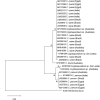Cryptosporidiosis and Giardiasis in Buffaloes (Bubalus bubalis)
- PMID: 33330686
- PMCID: PMC7673452
- DOI: 10.3389/fvets.2020.557967
Cryptosporidiosis and Giardiasis in Buffaloes (Bubalus bubalis)
Abstract
Cryptosporidium spp. and Giardia duodenalis infect the gastrointestinal tracts of animals and humans. Both parasite groups are distributed worldwide and cause significant economic losses in animal productivity. Infected hosts presenting with and without clinical manifestations can eliminate infective forms of these protozoa, which are particularly important to One Health. Compared to the published research on cattle, relatively few studies have examined the epidemiology of cryptosporidiosis and giardiasis in buffaloes. This short review describes the global occurrence of Cryptosporidium spp. and G. duodenalis in buffaloes, including the molecular techniques employed for the identification of species/assemblages and genotypes of these protozoa. Genetic analyses of isolates of G. duodenalis and Cryptosporidium spp. from various sources (environmental, animal, and human) have been performed to investigate their epidemiology. In buffaloes, the species Cryptosporidium parvum, Cryptosporidium ryanae, Cryptosporidium bovis, and Cryptosporidium suis-like have been characterized, as well as assemblages A and E of G. duodenalis. We demonstrate that buffaloes can be infected by species of Cryptosporidium spp. and G. duodenalis assemblages with zoonotic potential. Epidemiological studies that utilize molecular biology techniques represent an important resource for efforts to control and prevent the spread of these protozoans.
Keywords: Cryptosporidium; Giardia; assemblages; genotypes; water buffalo; zoonosis.
Copyright © 2020 de Aquino, Inácio, Rodrigues, de Barros, Garcia, Headley, Gomes and Bresciani.
Figures
References
Publication types
LinkOut - more resources
Full Text Sources
Miscellaneous


